2012 VOLKSWAGEN GOLF MK6 ESP
[x] Cancel search: ESPPage 237 of 516
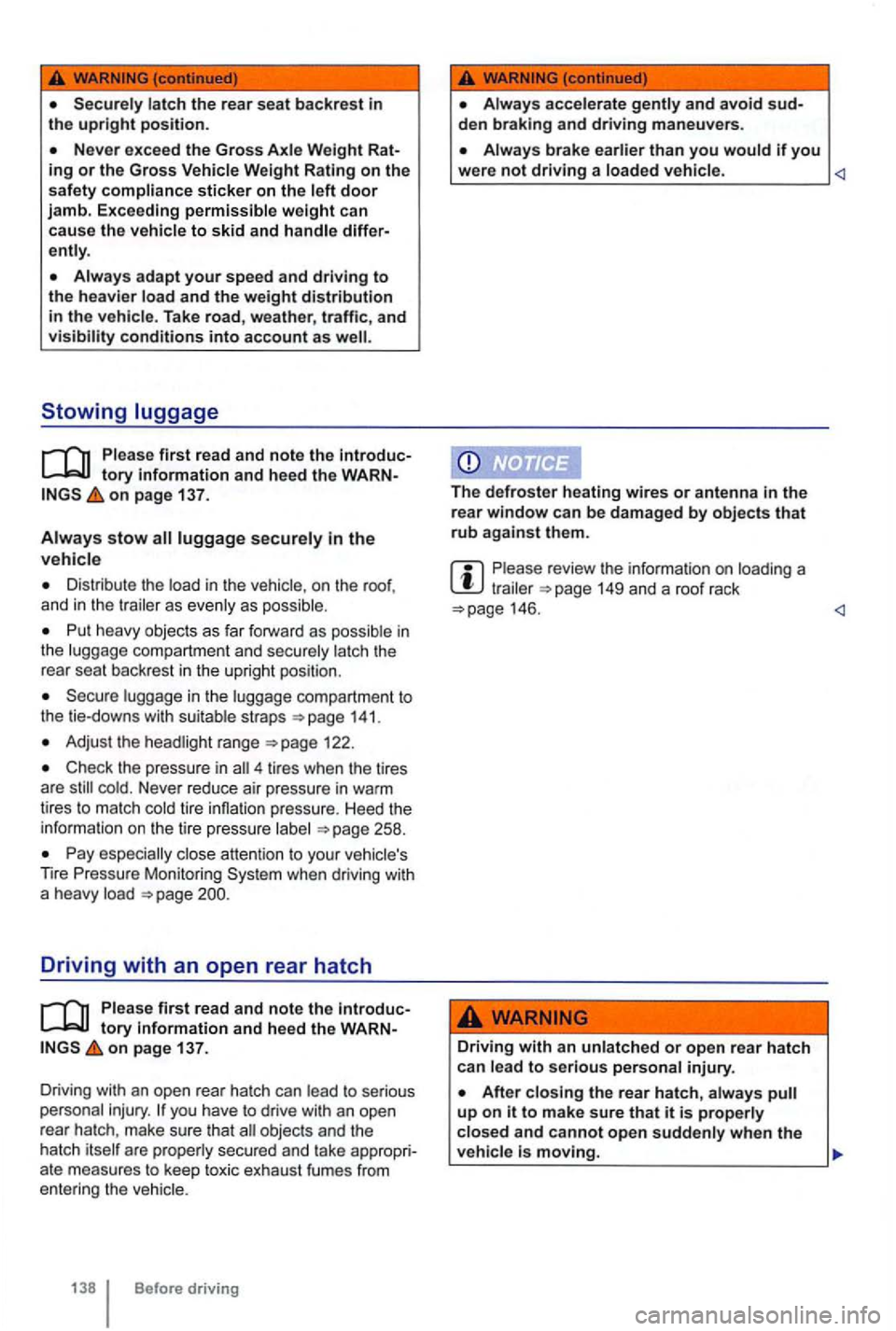
Never exceed the Gross Axle Weight ing or the Gross
Always adapt your speed and driving to
the heavier load and the weight distribution in the vehicle . Take road, weather , traffic, and visibility conditions into account as
Please first read and note the tory information and heed the on page 137.
Always stow luggage securely in the
Distribute the load in the vehicle, on the roo f,
and in the trailer as evenly as possible .
Put heavy objec ts as far forward as possib le in
the luggage compartmen t and securely latc h t he
rear seat backrest in the upright position .
luggage in the luggage compartmen t to
the tie-downs with su itable straps
Adjust the headlig ht range 122 .
Check the pressure in 4 tires when the tires
are
P ay especially close att enti on to your vehicle 's Tire Pressu re M on itoring
Driving with an open rear hatch
tory information and heed the on page 137.
D rivi ng with
an ope n rear hatch can lead to se riou s
personal injury. if you have to drive with an ope n
rear hatc h, make sure t hat objec ts and the
hatch it sel f are properly secured and take
Before d riving
den braking and driving maneuvers .
Always brake earlier than you would if you were not driving a loaded vehicle. <1
The defroster heating wires or antenna in the rear window can be damag ed by objects that rub against them.
Please review the in forma tion on loadi ng a tr ai le r 149 and a roof rack 146. <1
Driving with a n unlatched or open rear hatch
ca n lead to serious personal injury.
After clo sing the rear hatch, always
Page 245 of 516
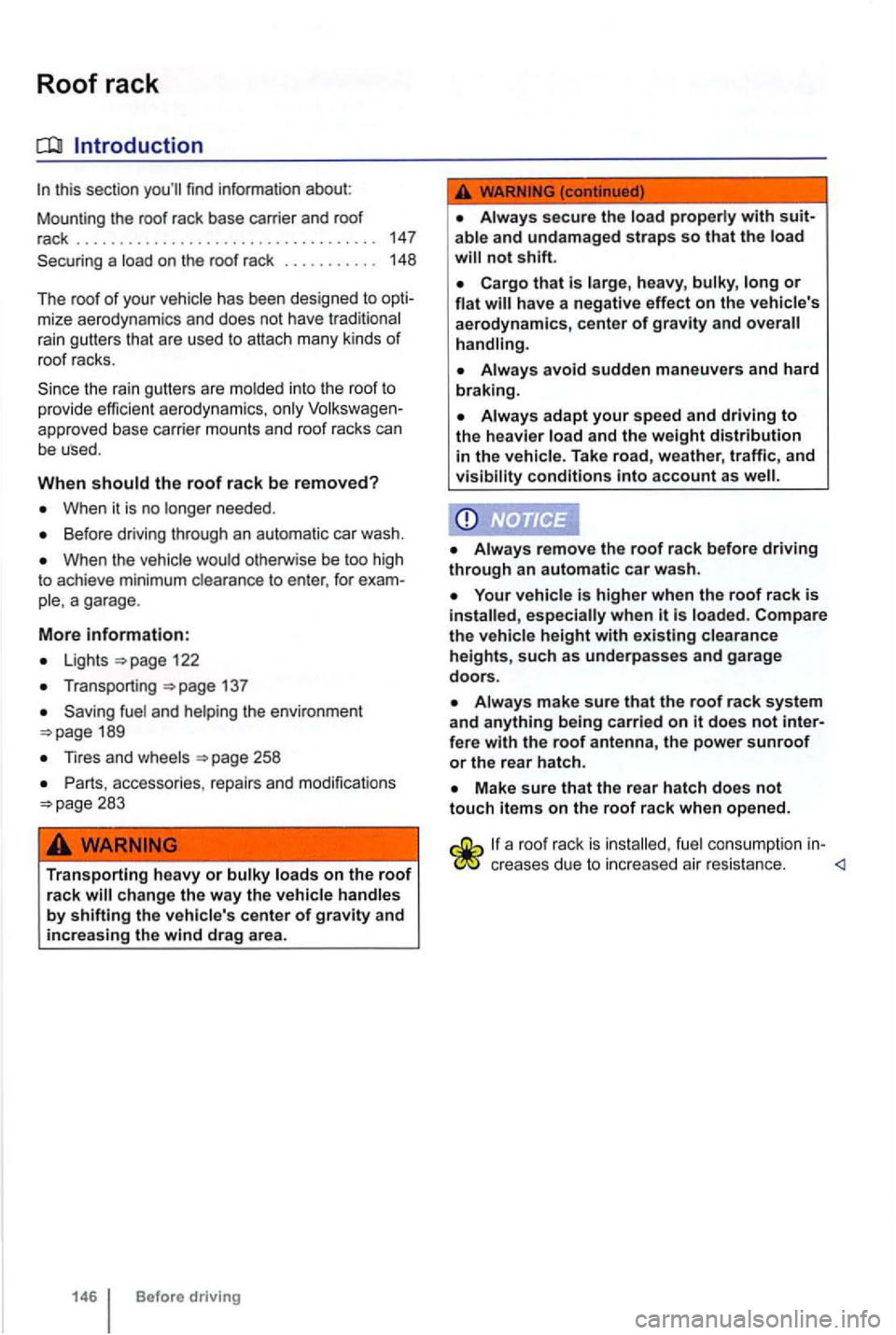
Roof rack
Introduction
this sectio n find informa tion about:
Mo unt in g the roof rack base carrier and roof
rack
................................... 147
Securing a load on the roof rack . . . . . . . . . . . 148
The ro of o f your vehicle has been designed to
approv ed base carrie r mounts and roof racks can
be used .
When should the roof rack be removed?
When it is no longer needed .
Before driving through an automatic car was h.
When the vehic le wou ld otherwise be too high
t o ach ieve min imum clearanc e to enter, for
ple, a garage .
More information:
Lights
Transporting 137
Saving fuel and helping the envi ronment
Tires and wheels 258
283
Transporting heavy or bulky loads on the roof rack will change the way the vehicle handles by shifting the vehicle's center of gravity and
increasing the wind drag area.
146 Before driving
able and undam ag ed straps so that the load
have a negative effect on the vehicle's
aerodynamics , center of gravity and ove rall
Your vehicle is higher when the roof rack is installed , especially when it is loaded. Compare
the vehicl e he ight with existing clear ance
heights , such as underpasses and garage doors.
creases due to increased air resis ta nce.
Page 252 of 516

Volkswagen Service Vehicles with Xenon
gas-discharge self-adjust to vehicle load
and do not need manual adjustment.
Special towing considerations
th e t railer has an overrun brake, apply the
br akes
Due to the combined towing weight including
the higher gross vehicle weight, the stopping
tance is longer.
Be fo re drivi ng especially on
The vehicle's center of grav ity and , in turn, the
Weight distribution is especially bad if the is emp ty and the trailer is loaded.
Depending on how steep the is an d the
backwards when you first start moving.
When starting off with a tra iler on a
Depress and hold the brake pedal and depress
and hold the clutch (manu al transmission).
171, Shifting .
Unlock the parking brake a nd gently release it
whi le holding the unlock button. At the same time,
release the brake pedal and
depress the
accelerator and, for manual transmissions , let out
the clutch
you can feel the car moving ward . applicable, follow the instruct ions for the Hold feat ure
Do not release the parking brake lever until the
engine starts to move the vehicle forward. your
vehicle has an automatic tr ansmission , you can
so depress and hold the brake peda l for added
b raking and then Jet up on the brake pedal when
you feel that the to move forward .
Drive ahead slowly.
hicle contro l and serious per sonal injury.
dles and increases the distance it needs to stop safely .
Always adapt your sp ee d and driving to th e heavier loa d and the weight distribution in the vehicle. Tak e road , weather , traffic, and visibility conditions into account as well .
Always avoid sudde n maneuv ers and ha rd braking.
atin g.
som e areas
s p ee d for vehicles towing trailers are
lower than for vehicles without trailers.
Page 258 of 516
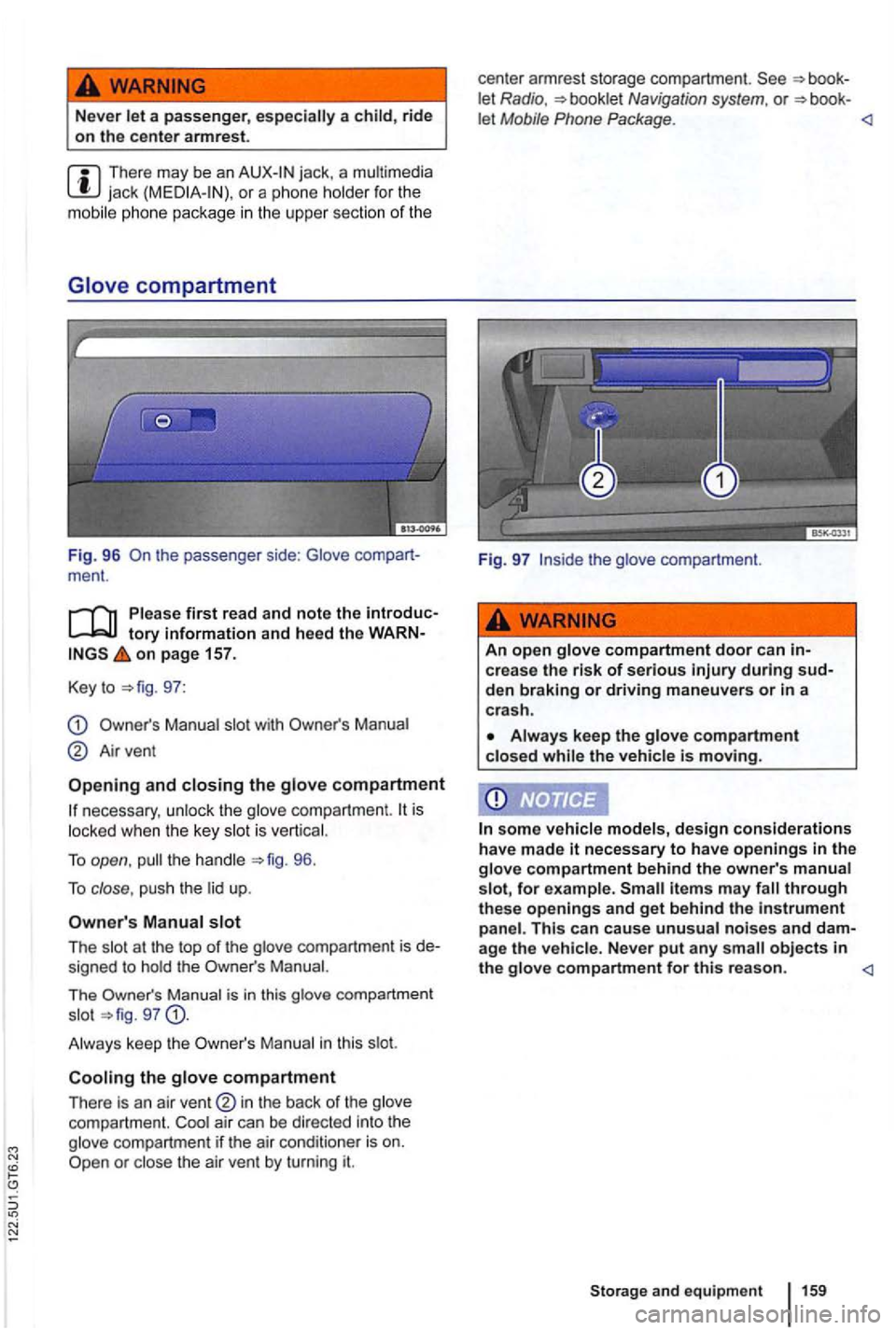
Never l et a passenger, espec ially a child, ride
o n the center armrest.
jack, a multimedia jack
t he passenger side: Glove ment.
on page 157.
Key to
97:
Manual slot with
Airvent
and closing the glove compartment
necessary , unl ock th e glove compartme nt. is
l ocked when th e key slot is ve rtical.
To open , 96.
To close , push th e lid up .
Manual slot
The slot at the top of the glove compartmen t is signed to hold th e Manual.
Th e
Man ua l i s in this glove compartment
s lo t g7
Man ual in this slot.
Cooling the glove compartment
There is an air in the back of the glove
compartment. Coot air can be directed into the
g love compartment if the air conditio ner is on.
let Radio , Navigation system. or let Mobile Phone Package .
Fig. 97
crea s e the risk of serious during
Always keep the glove compartment closed while the vehicle is moving.
some vehicle models, design considerations
have made it necessary to have openings in the glove compartment behind the owne r's manua l
s lot, for e xample.
a ge the vehicle. Never put any small objec ts in the glove compartment for this re a son.
Page 267 of 516
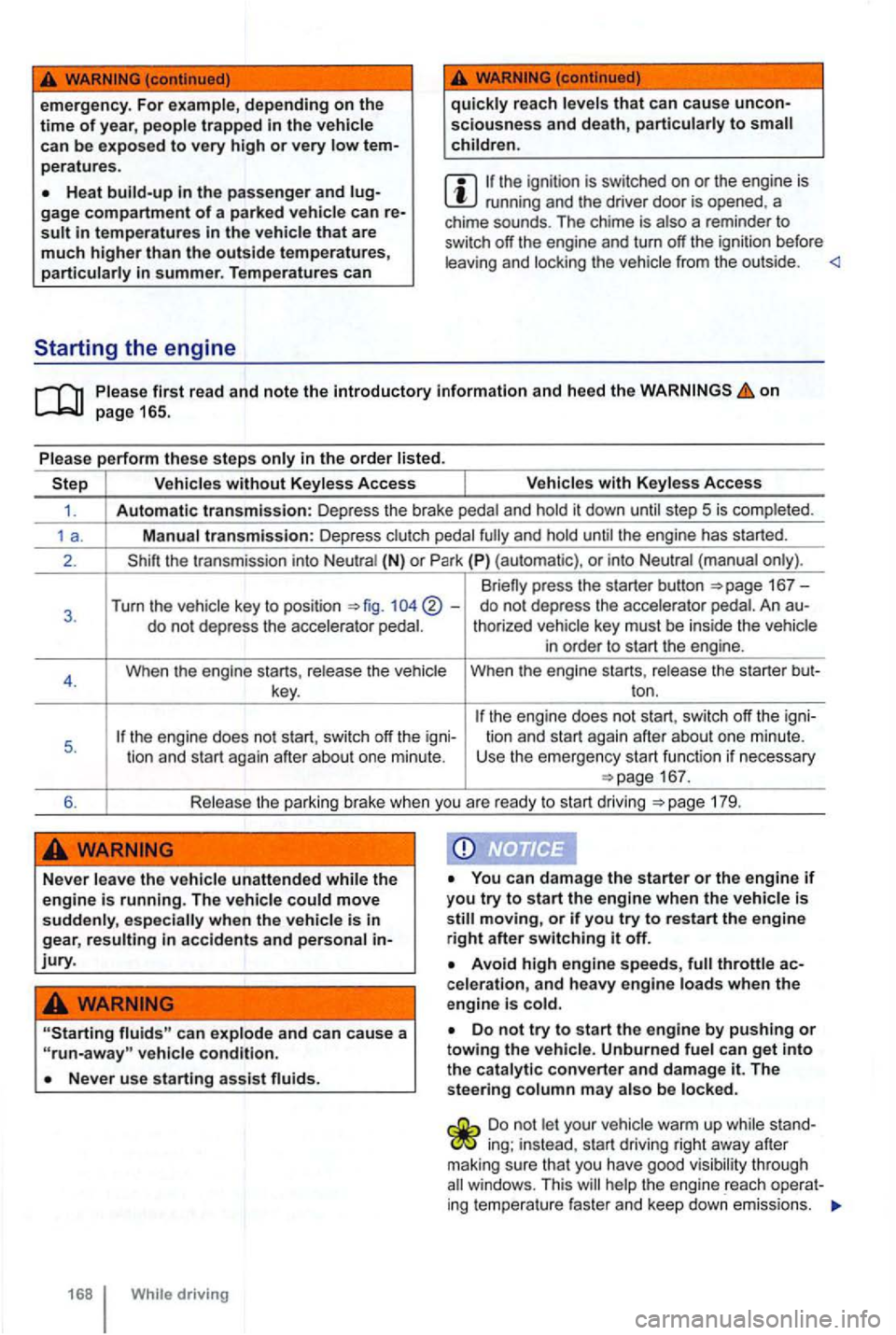
emergency. For example , depending on the time of year, people trapped in the vehicle
ca n be exposed to very high or very low tem
peratures .
Heat
quickly reach levels that can cause unconsciousness and death , particularly to
runn in g and the drive r doo r is op ened , a
chime sounds. T he chim e is also a re minde r to swi tch off the engine and turn off the ignition b efore
leavin g and locki ng th e veh icle from the out side .
(auto m atic) , or into Neut ral (manu a l o nly) .
167-
3. Turn the veh icle ke y to posi tion -do no t dep ress the accelerator p ed al. A n au-
do not depr ess the accele ra to r p ed al. t
h oriz ed vehicle key must be insi de t he ve h ic le
i n order to start th e engin e .
4 . Wh en the engi ne s ta rts, release th e v ehic le W
he n the e ng ine starts, release th e sta rte r but-
key . to n .
the engi ne does not start , swi tc h off the igni- tion an d s tart aga in after ab ou t o ne minute .
t io n and sta rt again after about one minut e. Use
the em ergenc y sta rt function if n ecessary 16 7 .
6 .
R elease the pa rking brake when you are ready to s tart dr iving 179 .
Never leave the vehicle unattended while the
engine is running. The vehicle could move suddenly, espec ially when the vehicle is in
gear, resulting in accidents and persona l in-jury.
can explode and can cause a vehicle condition.
Never use starting assist fluids .
moving, or if you try to restart the engine right after switching it off.
Avoid high engine speeds,
Do not le t your ve hicle warm up while stan ding; in stead . start drivi ng right awa y aft er making s ur e that yo u have good visib ilit y t hro ug h w indows. This help the e ngine reac h opera t
ing temp e rature faste r an d ke ep d own emissions.
Page 270 of 516
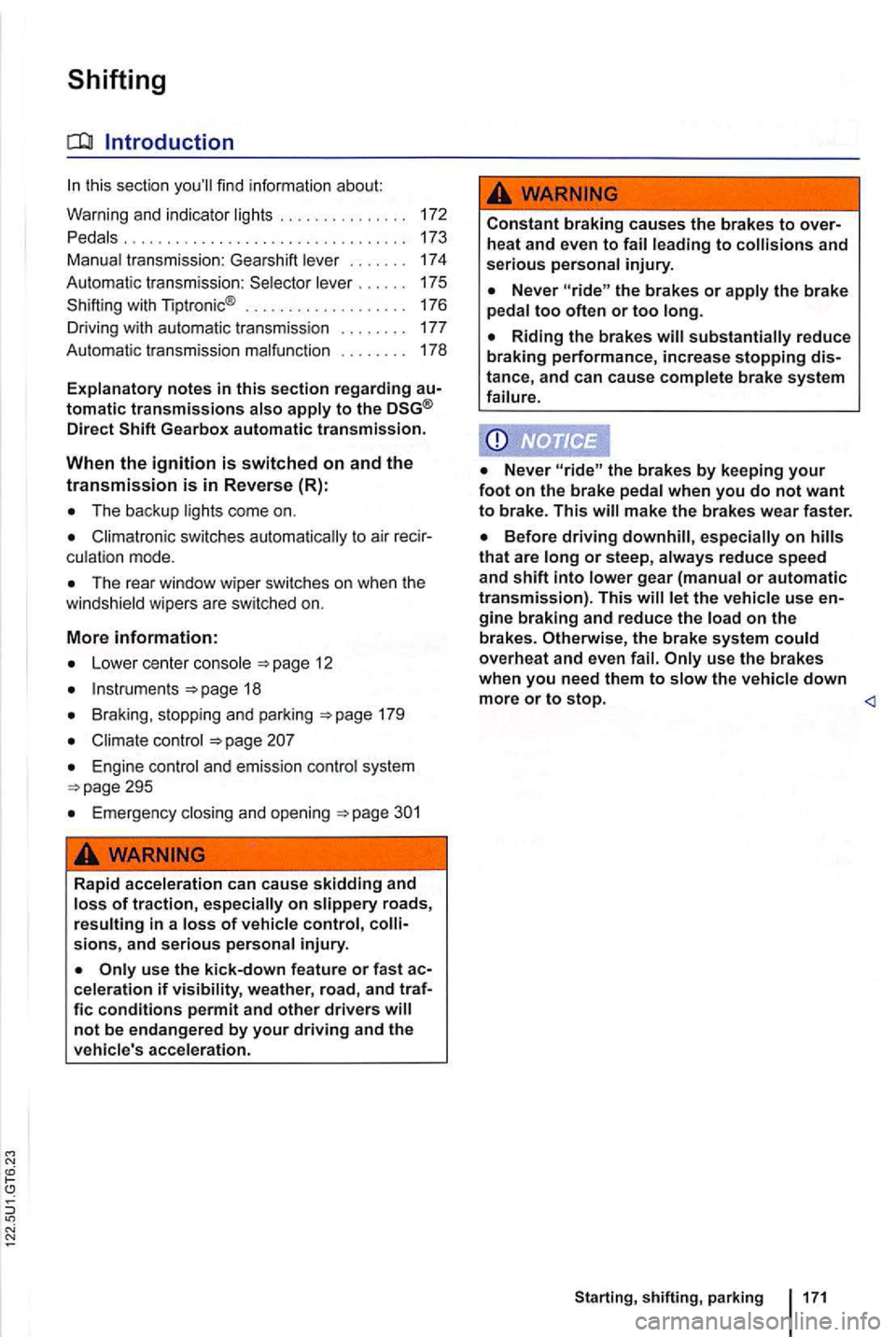
Shifting
Introduction
this section find information about:
Warning
and i ndicator ... .. . .
Pedals
............. ........... .
Manual transmission: Gearshift lever
172
173
174
Automat ic transm ission :
lever.... 175
Sh ifting with nptro nic ® . . . . . . . . . . . . . . . . . . 176
Driving with automatic transmiss ion 177
Automat ic transmission malfunction . . . . . . . . 178
Explanatory
notes in this sec tion regarding
Direct
The backup lights come on.
Climatronic switches to air culation mode.
The rear window wiper switches on when the
windshield wipers are switched on.
More information:
Braking , stoppi ng and parking 179
Climate control
Engine control and emission control system
Emergency
Rapid acceleration can cause skidding and loss of traction , especially on slippery roads,
re sulting in a loss of vehicle control, sions, and seriou s personal injury.
use the kick-down feature or fast cele ration if visibility, weather, road, and
Constant braking causes the brakes to and se rious personal injury.
the brakes or apply the brake
pedal too often or too long.
substantially reduce braking performance, increase stopping
the brakes by keeping your foot on the brake pedal when you do not want to brake . Thi s make the brakes wear faster.
gine braking and reduce the load on the brakes. Otherwise , the brake system could overheat and even
Page 271 of 516
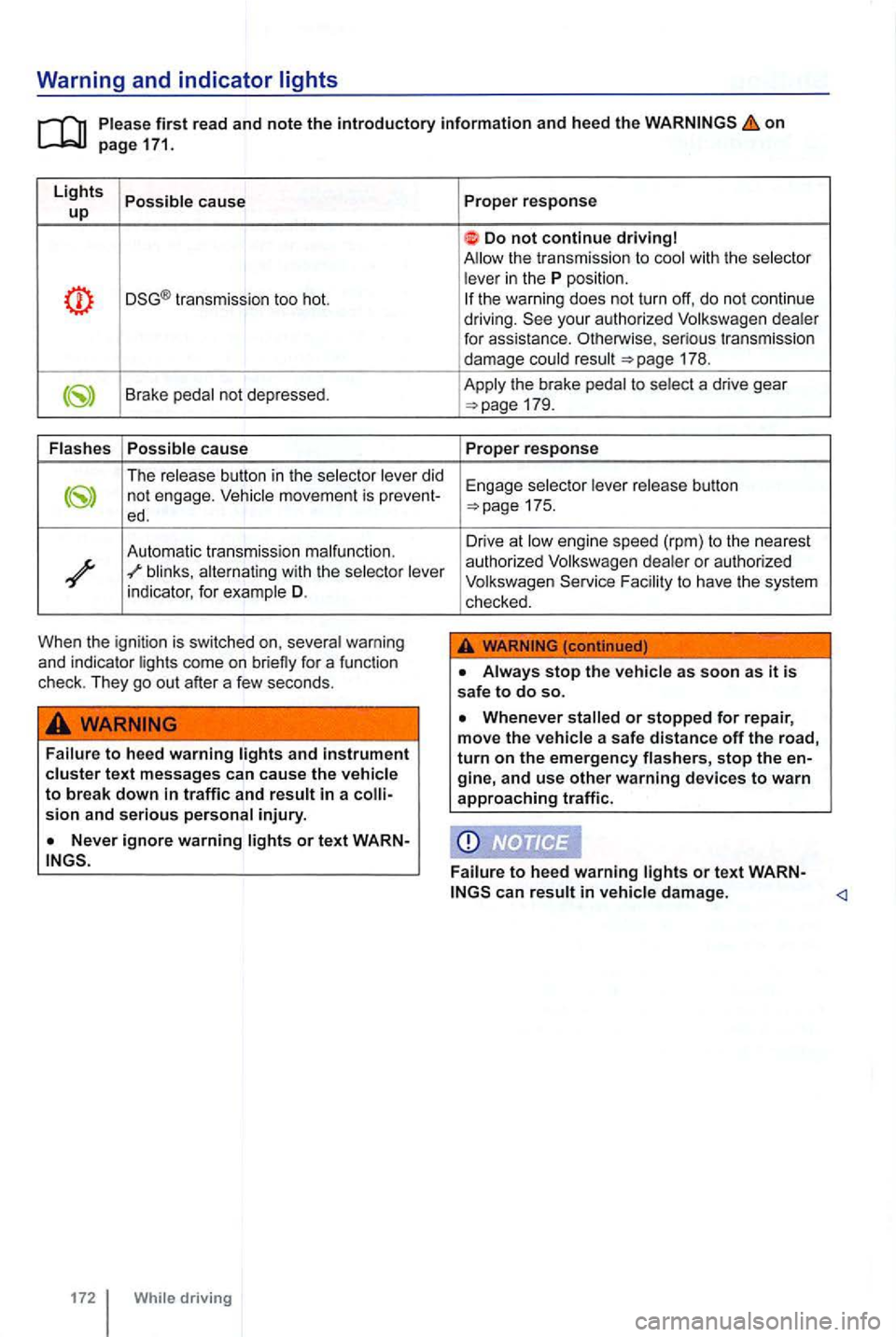
Warning and indica tor lights
on page 171.
L
ights Possible cause up
transmission too hot.
Brake pedal not depressed.
Flash es Possible
cause
The release button in the selector lever did not engage.
blinks, alternating with the selector lever
indicator , for example D.
When the ignition is switched on, several warning
and indicator lights come on briefly for a funct ion
check . They go out after a few seconds .
Failure to heed warning text messages can cause the vehicle to break down in traffic and result in a injury.
or t ext WARN
172 While driving Proper
response
Do not continue driving
the warni ng does not turn off, do not continue
driving.
175.
Drive at low en gine speed (rpm) to th e nearest
autho rized Vol kswagen dealer or authorized
Volkswagen F acility to have th e system
checked .
Always stop the vehicle as soon as it is safe to do so.
damage.
Page 283 of 516
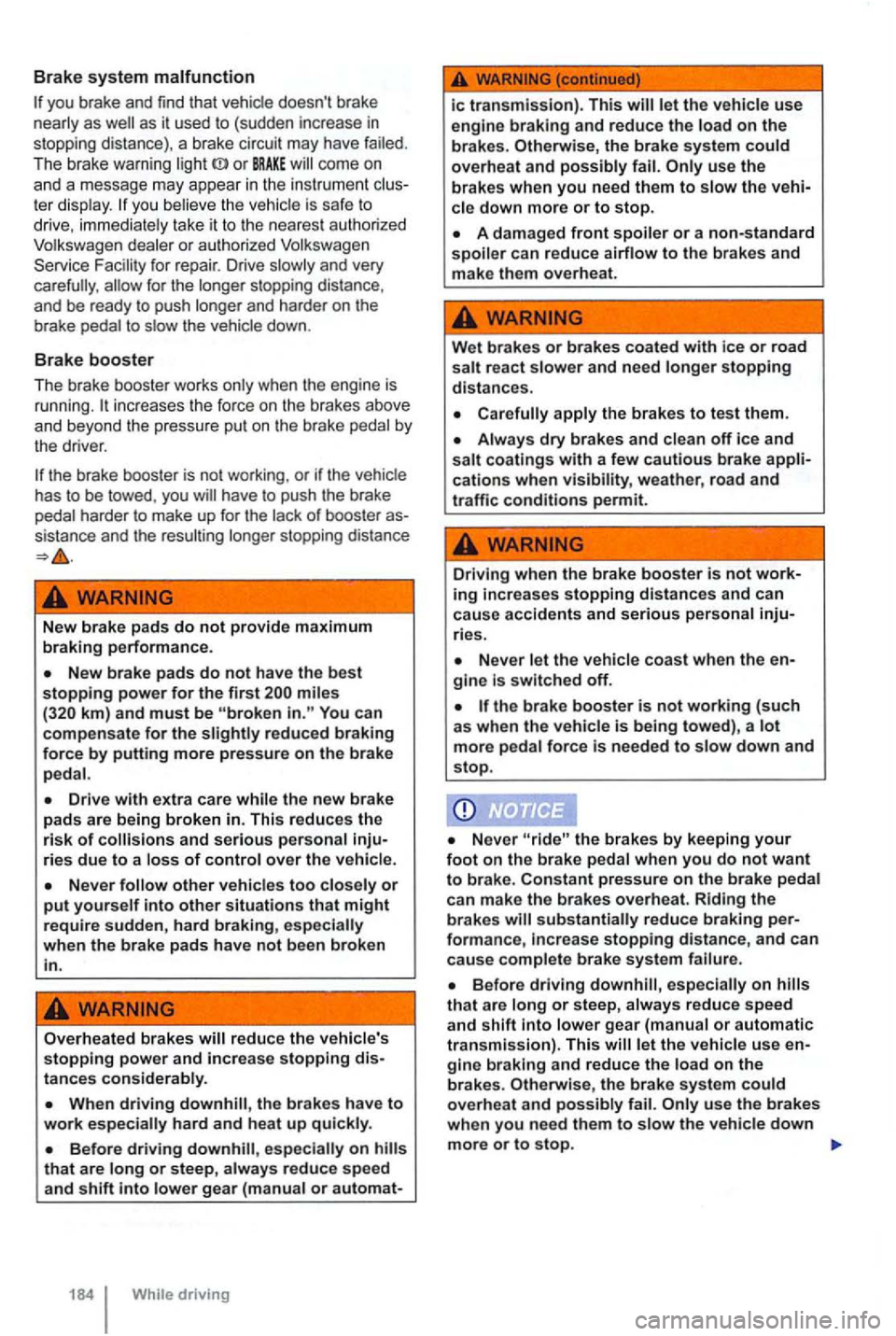
Brake system malfunction
you brake and find that vehicle doesn't brake
nearly as
come on
and a m essage may appear in the instrument ter display. you believe the vehic le is safe to
d rive, immediately take it to the nearest authorized
Volkswagen dealer or authorized Volkswagen
Service
f or repair. Drive slowly and very
carefully , for the longer stopping distance ,
and be ready to push longer and harder on the
brake pedal to slow the vehicle down.
Brake booster
The brake booster works only when the engine is
running . in creases the force on the brakes above
and beyond the pressure put on the brake pedal by
the driver .
New brake pad s do not provide maximum braking performance.
miles You can
compensate for the reduc ed braking force by putting more pressure on the brake
pedal.
other vehicles too closel y or put yourself into other situations that might require sudden, hard braking , especially
when the brake pads have not b ee n broken
in.
Overh eated brakes reduce the vehicle's stopping power and increa se stopping distances considerably.
that are long or s teep, always reduce speed
and shift into lower gear (manual or automat-
184 While driving
ic transmission). This let the vehicle use
engine braking and reduce the load on the brakes. Otherwise, the brake system could overheat and possibly fail.
A damaged front spoiler or a non-standard spoiler can redu ce airflow to th e brakes and make them overheat.
Wet brakes or brakes coated with ice or road
salt react slower and need longer stopping distances.
apply the brakes to tes t them .
Driving when the brake booster is not working increases stopping distances and can
cause accidents and serious per sonal inju
rie s.
Nev er let the vehicle coas t when the
the bra ke booster is not working (suc h
a s wh en th e vehic le is being towed) , a lot more pedal force is needed to slow down and stop.
Neve r the brake s by keeping your foot on the brak e pedal when you do not want to brak e. Constant pres sure on the brake ped al
ca n make the brak es overheat. Riding the bra kes substantially r educe brakin g performance, increase stopping distance, and can
cause complete brake system failure .
that are long or s teep, always reduce speed and shift into lower gear (manua l or automatic tran smission). This gine brakin g and reduce the load on t he brakes. Otherwise, the brake system cou ld
o ve rheat and possibly fail. use the brakes when you n eed them to slow the vehicle down more or to stop.